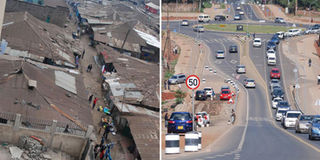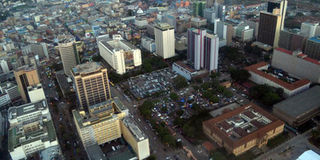Nairobi a replica of our socio-economic divisions

A section of a street in Majengo slums (left) and part of modern bypass through Kileleshwa, Nairobi which connects Ngong road and Waiyaki way. PHOTOS | NATION
What you need to know:
- A trip from one of the residential areas in the city’s generally chaotic eastern section to one of the serene, leafy suburbs west of Moi Avenue reveals lifestyles that are so different, leaving you wondering if you are in the same country
- Yet, as the two will come to know later, Kariokor and Kileleshwa are within five kilometres of each other, and in Kenya’s capital city.
- Paradoxically, matatus operating in this the upmarket area are as rickety as, if not worse, than those in Eastlands.
Imagine two aliens hijacked in the UK capital, London, blindfolded and dropped off in Kileleshwa and Kariokor in Nairobi respectively.
The person dropped off in Kileleshwa, near Kasuku Centre, would most likely think he is in some unfamiliar part of London.
If he’s hungry, he would ask for the nearest MacDonalds, and there being none, he would probably be directed to the nearest Kentucky Fried Chicken eatery, where he would enjoy something called “Original Recipe” or “Extra Crispy” in the clean, upmarket atmosphere.
The only thing that would seem out of place are the ramshackle vans with broken yellow lines and young Black men shouting, “Thirty bob, tao…faster…30…!”
By the time he is through with his meal, his colleague in Kariokor will most likely have died of shock — quite literally — thanks to the dust and pollution, and the sight of livestock, dogs and cats rummaging through the mountains of putrid garbage along the roads, paths, and on rooftops.
Mechanics, hawkers and scallywags occupy every inch of the space. He would know immediately, that he is in a hell hole of a fourth world country, or maybe not in this world at all.
Yet, as the two will come to know later, Kariokor and Kileleshwa are within five kilometres of each other, and in Kenya’s capital city.
The city, the two might get to learn, has been voted the “most intelligent city in Africa” and is also the place where some of the world’s top multinational companies are rushing to set up shop.
As the two compare notes, they will learn that the city of Nairobi is divided into two sections, with an imaginary line along Moi Avenue roughly drawing the social-economic contour of the city.
EAST AND WEST
The capital is good representation of the country’s sharp class differences and growing gap between — if you will excuse the cliché — the haves and the have-nots.
Everything changes depending on which side of Moi Avenue you are: To the west of the line, prices are as jaw-dropping as those along the Boulevard St Michel in the French capital, Paris, which is the first port of call for Hollywood’s glitterati.
The ritzy and glamorous shops have shoes with price tags reading Sh19,000 and suits that cost more than Sh30,000. And there are international-standard hotels like the Villa Rosa Kempinski, Novotel and the Caramel Restaurant & Lounge.
In these establishments, a bottle of a foreign cognac called Remy Martin Louis XIII, costs Sh1.25 million. A few drops of it (a tot) go for a staggering Sh42,000, which is more than many people’s monthly salary.
The Villa Rosa Kempinski Hotel recently rose to the limelight with its special Sh2.5 million for a room and pampering Valentine’s Night offer.
To the west of Moi Avenue are streets as colourful as those of Soho in London, with equally high prices to match.
The different mannerisms west of Moi Avenue are dramatic and fascinating Here, matatu drivers and touts miraculously discover traffic rules and decorum. The streets are less congested.
Hawkers (believe me) know this is a no-go zone. Other than the odd, street second-hand book stockist and specialists hawkers near some church or mosque, the chaos synonymous with the east of the city is rare here.
The difference between the west and the east becomes more apparent as you move further west into the posh, leafy suburbs. Here, by a quirk of nature, it is wetter, colder and, therefore, gnats and other irritating bugs find it hard to survive.
The roads are clean and smooth. The newly done road connecting Westlands and Ngong Road seems to have been constructed with great attention to detail.
RICKETY MATATUS
When DN2 flags down a matatu near the Kasuku Centre roundabout, the tout animatedly gestures that we go and wait for one at the nearby stage.
“We can’t stop there. You can’t tell who is driving behind you. Huko ni kwa wadosi (This is a residential area for the rich).” he explains. We nod, understanding what he means.
Paradoxically, matatus operating in this the upmarket area are as rickety as, if not worse, than those in Eastlands.
“Many workers come to this area from town daily… most of our customers are secretaries in companies with offices here, domestic workers, gardeners, night guards, and such people. We ferry them. I think they live in the poorer areas,” says the tout.
For the three days we commuted to Kileleshwa, we noted that most of the passengers were elegantly dressed young people, like young, early career workers.
One notable thing is that fares on these routes are comparatively higher. For instance, a trip from town to Chiromo, just two kilometres away, costs Sh50, which is the same amount matatus to Umoja, Kariobangi, and even Ruiru, 15 kilometres away, charge.
We asked why the fares were were higher than those in Eastlands but got no response.
A “smart bus” bus service launched several years ago on the routes to these areas flopped since it failed to attract the rich upmarket clientèle. Most residents prefer riding in the comfort of their vehicles.

An aerial view of Nairobi city centre. PHOTO | FILE
THE OTHER HALF
Now, across Moi Avenue to the east. Many residents of the upmarket suburbs can take years without crossing the dividing line.
The area, which is certainly a no-go zone for expatriates, has some notable features. The prices of the same goods drop considerably (apart from those in supermarkets).
Many shops on the west of Moi Avenue have branches on the eastern side, but selling the same goods.
Often, customers shopping on the west of Moi Avenue who don’t have the stomach to cross to the other east have to wait for the desired item to be fetched from a branch there. The price goes up accordingly.
The eastern side of the city offers a variety of items for sale to the middle- and low-income earners. Everything is sold here: Apart from the usual food, clothing, furniture and household appliances, you can get love potions to bring back your long lost loved one, mobile phone software, fake second-hard electric dildos (Yes, you read right!).
But the diversity is not reflected only in prices. On matters security, you are on your own once you cross to the east of Moi Avenue.
Your chances of getting mugged increase the further eastwards you move, with some places beyond Tom Mboya Street practically no-go zones at nightfall.
CHAOS RULE
Immediately to the east of Moi Avenue, the streets are crowded and getting around is difficult, especially during rush hour. Often, you have to literally elbow your way through the crowds.
The maddening din is occasioned by the ubiquitous retailers selling a variety of goods, from bootleg music, perfumes and sausages. The cacophony caused by the hooting of public vehicles and blaring speakers of all kinds of preachers are enough to make you deaf.
The crowd gets thicker the further you move eastwards.
Around the Ronald Ngala Post Office, the side streets are a sea of humanity, stretching across the road and spilling into the famous, open-air Gikomba market.
Drama and merriment are part of street life on this side of the city. Notably, nearly all the hawkers outside Naivas and Tusky’s supermarkets on Ronald Ngala Street are young women, with children strapped on their backs, playing on their lap or on the pavement.
It is evening when DN2 visits the area and some of the toddlers are in different stages of doziness. One tot crawls between my feet and quickly starts chewing on my trousers.
Her mother yanks her away and quickly asks (demands, actually) that I buy some underwear she is selling at Sh50 each.
Thereafter, things happen quickly.
First, someone whistles. Then, like a response to a military command, the women quickly gather up their wares, swing their babies onto their backs and melt into the approaching darkness.
It turns out that the whistling was a warning that County Council askaris had been spotted, so it was time to run since the askaris usually confiscate the hawkers’ goods.
I move towards the Ruiru-Thika Road matatu stage. There is a strong smell of tear gas. A young man zooms past me at terrific speed, with a young woman in high heels and a mini skirt in hot pursuit. Nobody seems to care why she’s chasing him.
The two disappear into the maze created along Ronald Ngala Street by number 45 matatus.
It is 7 pm when I leave town for Ruiru Town. It takes three hours to cover a distance of 20 km and it is close to midnight when I finally arrive home. To make matters worse, there is a blackout, so I just plonk myself down on the sofa.
____________
WHAT THE DIVISION MEANS
Everyone seems to have a different view of the variegated nature of the city
“Of course you find this kind of thing everywhere. The high-end hotels cater for different patrons. It is called differentiation in marketing. Once you enter there, you don’t pay just for the drink, you pay for the ambience, the class, or simply being associated with that hotel. Otherwise you could decide buy the same drink elsewhere,” says Martin Kaiga, a marketing agent.
Meanwhile, Dr Mary Kinyanjui, a researcher on urbanisation and economic informality at the Institute of Development Studies, University of Nairobi, sees Nairobi’s two sides as reflecting frontiers and boundaries that are obvious obstacles to efforts at reconstructing the urban fabric.
“The eastern side is one big African market, where informality is the key to survival. The other side is the Nairobi of post cards, where policies and orderliness are implemented with the aid of the government,” says the scholar.
WORRYING DEFINITION
As an example, Dr Kinyanjui points out that the modification of streets like Mokhtar Daddah and Mama Ngina meant decongest the city centre were only done on the west of Moi Avenue. However, cultural analyst Dr Joyce Nyairo says this division has been becoming less clear.
“At least culturally, it was so up to the 1970s. But with mismanagement and increasing population density, the cultural ethos has increasing become fluid,” she says.
Today you cannot draw an arbitrary line to designate the social-cultural and economic perimeter of the city, as blue-chip companies like Kenya Airways have set up shop in River Road, which indicates the sheer size of the economy in the seamier part of the city,” says Dr Nyairo. “You find high-end goods at Nakumatt, The Junction and on a nearby street, the same goods are available at much lower price, so that people quickly choose where they fit.”
However, a report by the Swedish Institute of International affairs titled Divided cities: Challenges to Peace Building and Development, offers a worrying definition of Nairobi.
“Sarajevo, Nairobi and Jerusalem are all poignant symbols of violent conflict in our time. In a divided city, citizens end up living like ‘intimate enemies’ next to a frozen front where the formation of boundaries are linked to ethno-national identity construction and power relations and these divides, frontiers and boundaries are obvious obstacles to efforts at reconstructing the urban fabric,”





